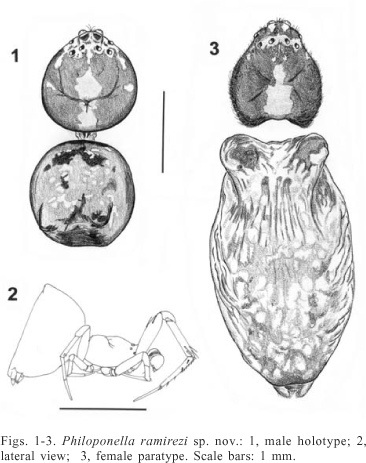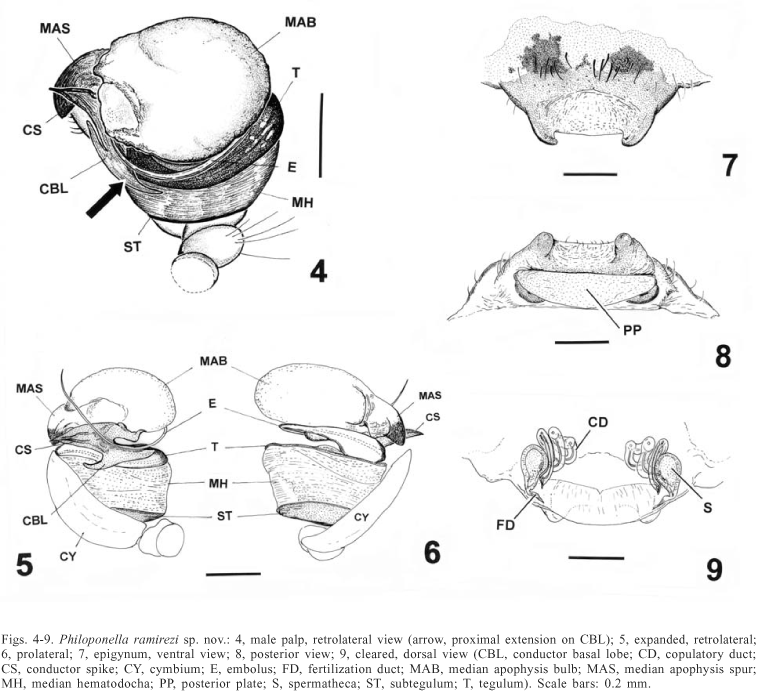Abstract
Two new species of the genus Philoponella Mello-Leitão, 1917 are described: P. ramirezi, from the Atlantic forest of the State of Minas Gerais, Brazil, and P. pomelita, from the subtropical forests of the Province of Misiones, Argentina. Relationships of these new species are discussed.
Uloboridae; Philoponella; taxonomy; Neotropical
Two new species of the genus Philoponella from Brazil and Argentina (Araneae, Uloboridae)
Cristian J. Grismado
Museo Argentino de Ciencias Naturales "Bernardino Rivadavia", División Aracnología, Av. Angel Gallardo 470 C1405DJR, Buenos Aires, Argentina. (grismado@macn.gov.ar)
ABSTRACT
Two new species of the genus Philoponella Mello-Leitão, 1917 are described: P. ramirezi, from the Atlantic forest of the State of Minas Gerais, Brazil, and P. pomelita, from the subtropical forests of the Province of Misiones, Argentina. Relationships of these new species are discussed.
Keywords: Uloboridae, Philoponella, taxonomy, Neotropical.
INTRODUCTION
The Uloboridae comprises small to medium-sized cribellate web-building spiders that lack venom glands and has cosmopolitan distribution, with a remarkable diversity in Central and South America (OPELL,1979, 1981, 1983). The pantropical genus Philoponella Mello-Leitão, 1917, distributed also in Africa, southeastern Asia and Australia, is the most speciose group found in America, with 16 species currently known from southern United States to northern Argentina (PLATNICK, 2003). The genus is recognized by the following diagnostic characteres: males with a nearly round carapace with a broad and transverse thoracic groove and palpus with a well developed conductor spike; females have a ventral epigynal atrium with two lateral lobes that form a posterior margin (OPELL, 1979).
It is well known that some species live in colonies where numerous orb-webs are built in a common network of supporting threads; in several species cooperative prey capture has been observed (MATSUMOTO, 1998), other colonies (or individual webs), are found associated with spiders of other families as Dipluridae, Eresidae, Araneidae, Tetragnathidae, Theridiidae, Agelenidae, and Psechridae (OPELL, 1979; BRADOO, 1986; ELGAR, 1993). OPELL (1979:520), in his revision of uloborid genera, subdivided the American members of the genus in three species-groups: republicana, fasciata and semiplumosa on base of genital features.
Two new species are described: P. ramirezi, from the Atlantic forest of Minas Gerais, Brazil, and P. pomelita, from the subtropical forest of Misiones, Argentina. Both species have confusing relationships that are discussed below.
MATERIAL AND METHODS
Specimens are deposited in Museu Nacional, Universidade Federal do Rio de Janeiro (MNRJ, A. B. Kury) and Museo Argentino de Ciencias Naturales, Buenos Aires (MACN, C. L. Scioscia). The format of descriptions and the terminology for palpal sclerites follows mostly OPELL (1979), to facilitate comparisons with previously described species (see CODDINGTON, 1990:12). Abbreviations for eyes are standard for Araneae. Female genitalia were cleared with clove oil, male palpi were expanded with KOH solution and observed with compound microscope. All measurements are in millimeters.
Philoponella ramirezi sp. nov.
Types. Male holotype and female paratype from Brazil, State of Minas Gerais, Alto Caparaó, Parque Nacional Serra do Caparaó, Vale Verde, 1100 m, 9.VI.1994, Martín J. Ramírez (MNRJ); 1  , 2
, 2  paratypes, same data (MACN 10043).
paratypes, same data (MACN 10043).
Etymology. The specific name is a patronym in honor of my friend and teacher Martín J. Ramírez, who collected all the specimens here described, and in recognizion for his permanent guide, assistence and encouragement to my work.
Diagnosis. Males of Philoponella ramirezi resemble those of fasciata group by having a distal prong on the conductor basal lobe, but differ by having a proximal extension on it (opposite to the prong), and by the blunt median apophysis spur (figs. 4-6). Females share coiled copulatory ducts with P. semiplumosa (Simon, 1893), P. oweni (Chamberlin, 1924) and P. arizonica (Gertsch, 1936) (fig. 9; OPELL, 1979, figs. 252, 263) but are clearly distinguished by their epigynum with a shallow anterior rim and the two lateral projections not medially fused, posteriorly directed (figs. 7, 8).
Description. Male (holotype): total length 2.84, carapace length 1.22, sternum length 0.70, leg I, length of articles: femur 1.28, tibia 0.98, metatarsus 1.10, tarsus 0.62. Carapace (fig. 1) brown with a light yellow central band, margins and ocular area yellow. Tibiae, metatarsi and tarsi I, pale orange, with diffuse annular distal dark bands on tibiae and metatarsi IV, rest of the legs, yellowish; sternum and endites light brown with darker margins, labium brown. Abdomen higher than long (fig. 2), with two very high humps; light gray background with a diffuse dark gray band back from the dorsal tubercles, ahead of them there is a V-shaped black spot; ventrally uniformly gray with brown pre-epigastric area. Spinnerets ligth brown. Palp (figs. 4-6): height and width of retrolateral femoral tubercle nearly equal.
Female (paratype, MNRJ): total length 3.88, carapace length 1.20, sternum length 0.78, leg I, length of articles: femur 1.30, tibia 1.16, metatarsus 1.20, tarsus 0.62. Carapace piriform, brown with the central band and ocular area yellowish (fig. 3); sternum ligth brown with a yellowish central band; legs as in male but with annular diffuse bands, more evident on femora I and II. Abdomen very high with two big humps; gray with scattered dark dots mixed with white guanine deposits; slightly darker ahead the humps, two consecutive black irregular marks in front; venter light gray, slightly darker in pre-epigastric area; spinnerets light brown. Epigynum: figs. 7-9.
Philoponella pomelita sp. nov.
Types. Male holotype and female paratype from Argentina, Misiones Province, Parque Provincial Cruce Caballero, NW San Pedro, 27-29.X.1995, Martín J. Ramírez (MACN 10247 and 10248 respectively).
Etymology. The specific name is an arbitrary combination of letters.
Diagnosis. Males of Philoponella pomelita differ from all other known american species by the shape of the median apophysis spur, which lacks a sharp terminal sclerite, but has a groove where the tip of conductor spike fits (figs. 10, 11, 13); females resembles P. herediae by the absence of an anterior epigynal rim and by having an anteriorly directed epigynal crypt (fig. 14; OPELL, 1987, fig. 4); but this crypt is shallower than in the Costa Rican species, has a ticker posterior border, and its copulatory openings are further separated and rounded by semicircular sclerotizations (figs. 14, 15); the copulatory ducts (fig. 16) are lesser convoluted than those of P. herediae (OPELL, 1987, fig. 5).
Description. Male (holotype): total length 1.66, carapace length 0.76, maximum carapace width 1.64, sternum length 0.44, femur I length 0.74. Carapace (fig. 12) yellowish with two wide paraxial grayish brown bands; fovea shallow and narrow transverse; legs light yellowish (except tibiae, metatarsi and tarsi I, paler orange; and diffuse annular gray bands in distal parts of tibiae and metatarsi IV); sternum and endites light brown with dark margins, labium grayish brown. Abdomen oval, without humps, cream background with a dark gray design in a chevron, white guanine deposits among the lateral extensions of the design; venter cream with a wide brown band between pedicel and spinnerets; epigastric area slightly darker; spinnerets yellowish. Palp (figs. 10, 11, 13): femur with a small proximal tubercle; embolus not visible, concealed under the median apophysis bulb.
Female (paratype): total length 2.24, carapace length 0.88, maximum carapace width 0.64, sternum length 0.48, femur I length 0.84. Carapace piriform; AME relatively larger than those of other congeneric species; color of cephalothorax and legs similar to the male except in the following aspects: the paraxial bands extend to the lateral margins and are more widely separated in the middle, leaving a wider and less regular yellowish central band. Abdomen (crushed) uniformly light brown darkening to the caudal area, with disperse white guanine deposits; spinnerets yellowish except the basal article of the posterior lateral, gray. Epigynum (figs. 14-16).
Other material examined. Misiones Province, Parque Nacional Iguazú,  , 23-26.X.1995, M. J. Ramírez (MACN 10249).
, 23-26.X.1995, M. J. Ramírez (MACN 10249).
DISCUSSION
Females of P. ramirezi are, by internal genital structures, almost identical to those of the North and Central American species of the semiplumosa group, but the males are, by virtue of the distal prong on the conductor, very similar to those of the fasciata group (specially P. para Opell, 1979).
The female of P. pomelita resembles those of the Costa Rican species P. herediae Opell, 1987 (of which the males are unknown); individual of both species are small and have similar genital features; they have anteriorly directed (rather than ventrally) epigynal crypt (fig.14; OPELL, 1987, fig. 4). In the original description, P. herediae was placed in the semiplumosa group by virtue of the clypeus heigh, the extreme lateral position of the epigynal openings and looped copulatory ducts. However, Opell recognized other very distinctive characteres. Thus, female genitalic features suggest that P. pomelita and P. herediae are sister species. In addition to possessing a distal prong (as those of the fasciata group), males of P. pomelita have a median apophysis spur that is unique in the American members of the genus. It has a groove (instead of a sharp sclerite) where the tip of conductor spike fits (figs. 10, 13). The male and female genitalic characteres appear to be synapomorphies of these two small species, making Philoponella species assemblage more complex than originally suggested by OPELL (1979). Consequently, until phylogenetic studies can be conducted, I cannot assign the two new species to any of the previously proposed groups.
Acknowledgments. Helpful comments on the draft of the manuscript were provided by Martín J. Ramírez (Museo Argentino de Ciencias Naturales, Buenos Aires), Brent D. Opell (Virginia Polytechnic Institute and State University, Blacksburg) and an anonymous reviewer. To MJR and the Microscopy and Imaging Facility, American Museum of Natural History, for the SEM micrographs. To the institutions and curators by the loan of specimens.
Recebido em maio de 2003
Aceito em janeiro de 2004
- BRADOO, B. L. 1986. Feeding behaviour of a non-poisonous spider Uloborus ferokus Bradoo (Araneae: Uloboridae). Zoologischer Anzeiger, Leipzig, 217(1/2):75-88.
- CODDINGTON, J. A. 1990. Ontogeny and homology in the male palpus of orb-weaving spiders and their realtives, with comments on phylogeny (Araneoclada: Araneoidea, Deinopoidea). Smithsonian Contributions to Zoology, Washington, 496:1-52.
- ELGAR, M. A. 1993. Inter-specific associations involving spiders: kleptoparasitism, mimicry and mutualism. Memoirs of the Queensland Museum, Brisbane, 33(2):411-430.
- MATSUMOTO, T. 1998. Cooperative prey capture in the communal web spider Philoponella raffrayi (Araneae, Uloboridae). The Journal of Arachnology, Lubbock, 26:392-396.
- OPELL, B. D. 1979. Revision of the genera and tropical American species of the spider family Uloboridae. Bulletin of the Museum of Comparative Zoology, Cambridge, 148:443-549.
- __. 1981. New Central and South American Uloboridae (Arachnida, Araneae). Bulletin of the American Museum of Natural History, New York, 170:219-228.
- __. 1983. Checklist of American Uloboridae (Arachnida: Araneae). The Great Lakes Entomologist, East Lansing, 16(2):61-66.
- __. 1987. The new species Philoponella herediae and its modified orb-web (Araneae, Uloboridae). The Journal of Arachnology, Lubbock, 15:59-63.
- PLATNICK, N. I. 2003. The world spider catalog American Museum of Natural History. Available online at: http://research.amnh.org/entomology/spiders/catalog81-87 /intro1.html
Publication Dates
-
Publication in this collection
29 June 2004 -
Date of issue
Mar 2004
History
-
Received
May 2003 -
Accepted
Jan 2004





